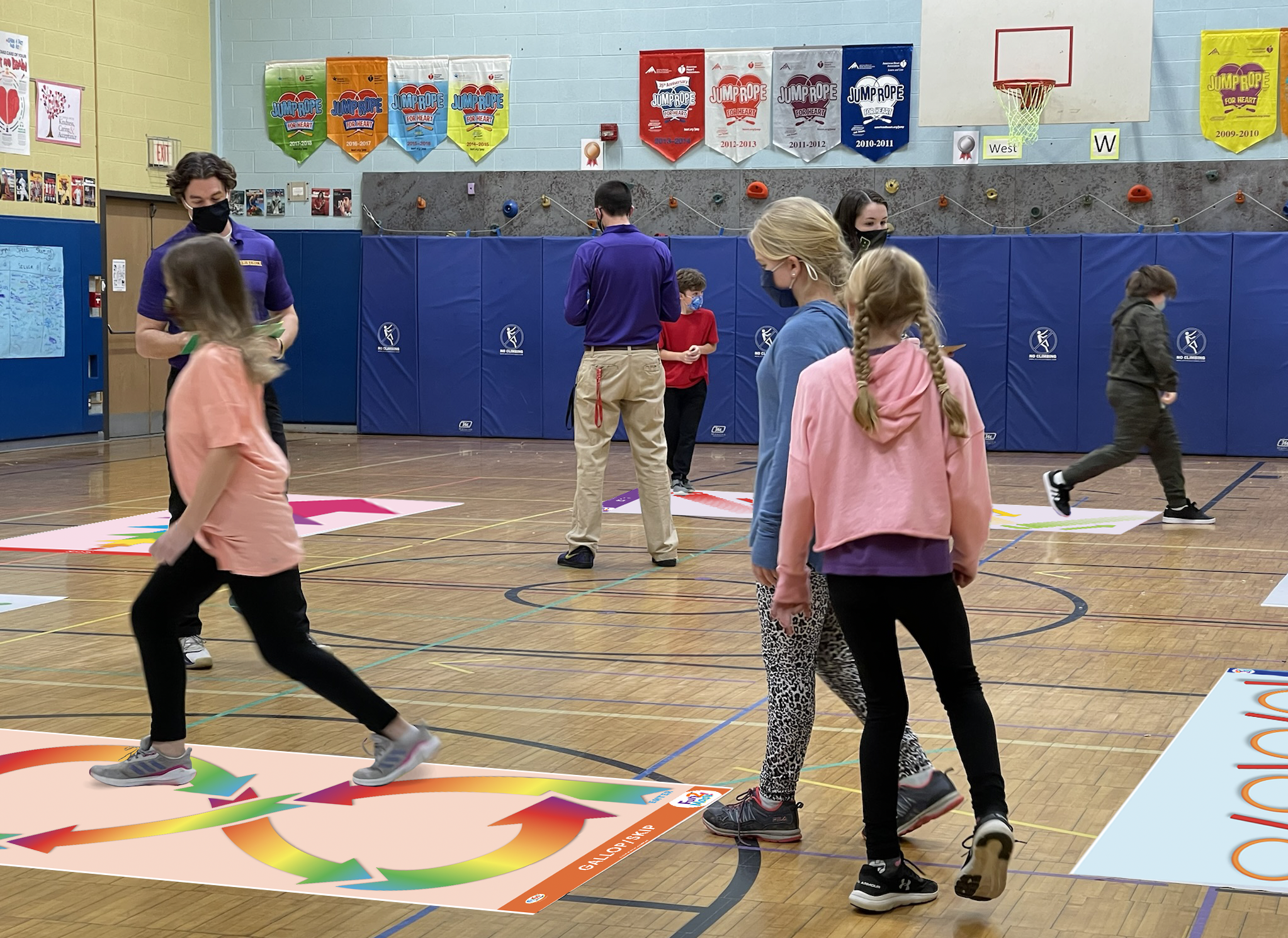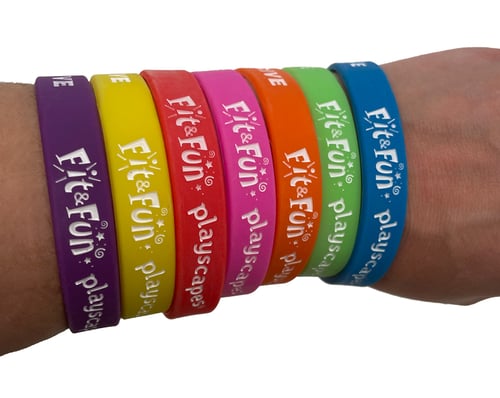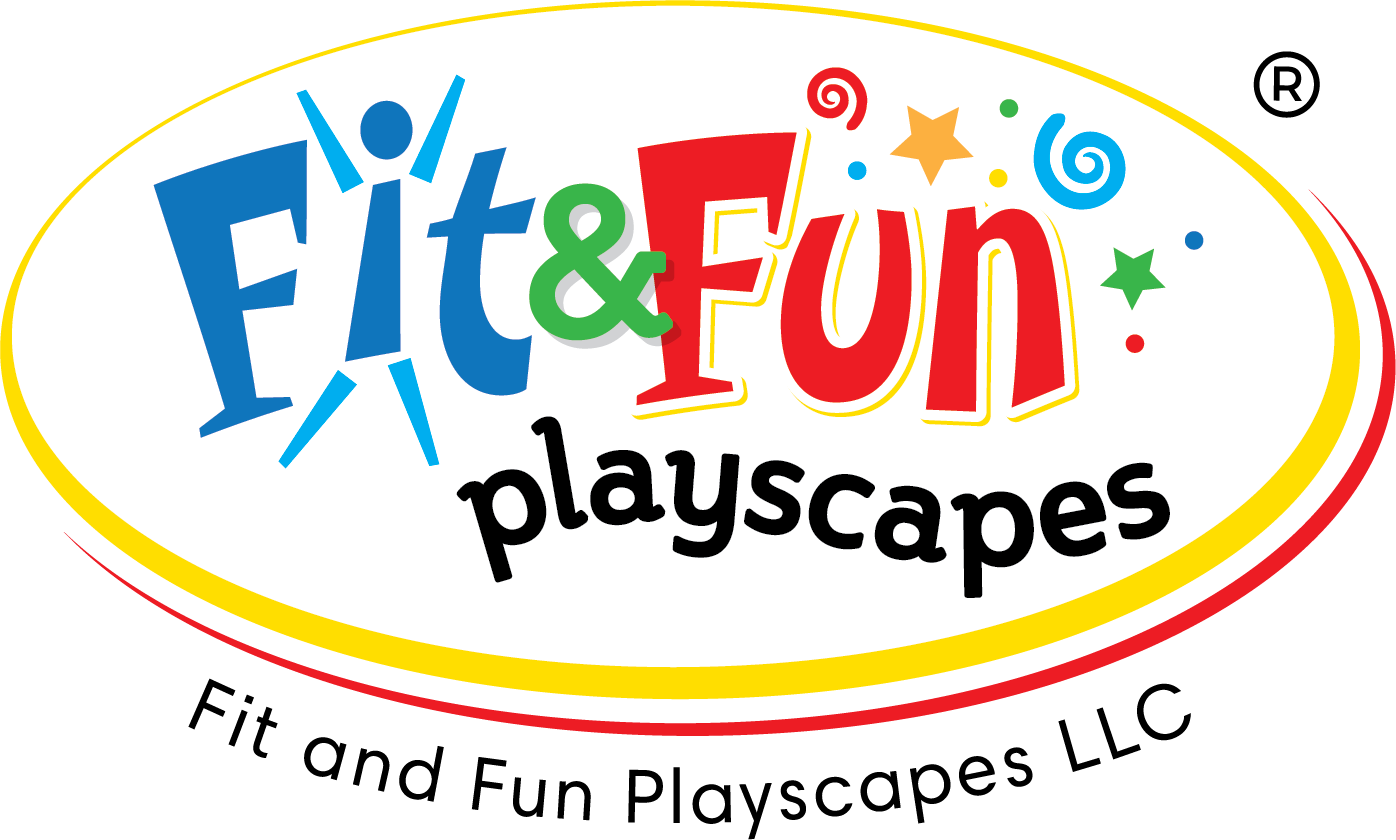15 strategies to address large classes in PE! – PART 3
– Written By Dr. Timothy Davis –
As the final installment of the series on managing large class sizes, I want to share an idea that
I recently revisited when using the Fun2Moov!® Locomotor Skills Assessment System.

In my last blog we discussed the importance of CONNECTING with your students individually. We also suggested that this is CRITICAL to creating an environment that is safe and inclusive. However, we know this is often difficult with large groups – so how can we make sure we CONNECT with our students? COLOR! Yes, using COLOR is a great way to efficiently manage groups and stay organized. This is a great way to get students moving with minimal verbal directions allowing the teacher to have more time to CONNECT! Specifically, using colored wrist bands with color poly spots and color stations affords not only teachers with a simple way to engage large groups it affords students choice too! Even your youngest students will be able to participate with this approach.
I would like to give a quick shout out to our friend and 2017 National Elementary PE TOY
(Teacher of the Year) Mrs. Lori Bifarella. She agrees that CONNECTING with your students is
an everyday critical issue and shared with me some of her favorite ways to connect and
manage large groups. In fact, she too uses COLOR when sharing professional development
ideas for large groups.
Check out the strategies below!
Using Colored Wrist Bands to Manage Large Groups
In addition to the Fun2Moov!® Locomotor Skills Assessment System, Fit and Fun Playscapes has colored wrist bands in 7 bright and distinct colors. Currently, the Fun2Moov® does not include the wristbands mentioned in this blog; however, if you would like some wristbands, please contact the Fit and Fun team and we'll be happy to include some in your order while supplies last. The wristbands are made of a type of rubbery plastic (like most) which makes them durable, easy to clean and difficult to break. They come in small (UPK/K-1), medium (2-5 th grade) and large (6th - 8th grade). Prior to using wristbands I make sure to tell students to choose ONLY ONE – DO NOT put it in their mouth to chew and DO NOT try to pull it apart or break it. Students can place it on either wrist (student choice). The colors of the Fit and Fun Playscape Bands are:
RED, YELLOW, GREEN, BLUE, ORANGE, PURPLE, and PINK

All you need is 7-10 of each color (the total number for each bin depends on the average class size you teach). I have these available to students in 7 clear bins (plastic “cookie jars” saved from the lunchroom). Depending on the number of stations I am using in that lesson – will depend on how many colors I choose to put out. For example, if using the Fun2Moov!® System (there will be 6 locomotor stations). Additionally, you will need to know how many students you have in that class when ALL are present. I do understand that on any given day you will have students absent. I will address this and how to address odd numbers too.
When I put the bins out for that class, I will start with 5 of each color in a bin (knowing I have 30 students in my class). I put the bin next to the gym entrance on a bench and as the students enter, I remind them to choose ONE color wristband. Of course, friends will often choose the same color wristbands – and that’s ok because student CHOICE is empowering and an important part of this approach. However, keep in mind that there should only be about 5-6 in each color group. I will share with you in a moment how I address mixing the groups. After the students have chosen their wrist band and have entered the gym, you can have them sit or stand in their color groups or you can have them find a poly spot that matches that color placed in the center of the gym (see Fun2Moov!® diagram). This approach allows you to not only see the total number of students in attendance (count wristbands) or numbers by color group etc. Lots of ways to quickly take attendance. In addition, if you find that you have an odd number or that your groups are not even – you can quickly add or switch a person out by giving them a color that balances out the groups or keeps two students you know don’t work well together apart.
There are so many ways to start your class with a warmup. I like to use Go Noodle, but you can use your own music and activities. I have my students (after entering the gym and selecting a wristband) find a poly spot. The poly spot they stand on does not have to match their wrist band. You can ask them to find the same color as their wrist band or not – that’s really up to you and the ability of your students. Additionally, you can have the students sit or stand in their color group before starting warmup.
Begin your warm up. One strategy to see how well your students are listening is to do a “warm up battle”. Have fun by calling out various colors (e.g. Blue). The color group that is called must perform a warm up (e.g., dance, shake, run in place, etc) to the best of their ability. Each “battle” lasts 10 seconds. After calling out the 6 groups – select one group as the “battle” winner. This group (e.g. Red) moves to their designated color station first. In other words, RED wristbands move to the red Fun2Moov!® Station Mat and starts their station. Follow with the various colors one at a time until all the colors have been called and the various color groups are at their station. Begin your lesson rotating CLOCKWISE one station at the end of the timed circuit.
Color Wristband Variations:
Call out Rainbow Group (one color only represented in the group) R/Y/B/G/O/P/P. Or call out students in groups of 2 or 3 by color. The number of variations is endless, and all depends on the task you want the students to do. In the end, the color bands afford teachers a quick way to organize large groups of students.
Handling large class sizes in physical education (PE) ALWAYS presents unique challenges, but PE teachers can employ various strategies to create a positive and effective learning environment. Consider using the color wristbands as “exit slips” again to ensure that you CONNECT with your kiddos as they leave the gym.
The following outlines additional strategies to help you be an effective teacher:
Clear Communication:
Establish clear and concise communication with students. Ensure they understand instructions, rules, and expectations. Use visual aids or demonstrations to enhance understanding. Explain the color wristbands and be sure to remind the students to not put it in their mouth or try to pull them apart.Efficient Equipment Management:
Organize and set up equipment in advance to minimize downtime. Consider using equipment that is easy to distribute, set up, and put away quickly. We love using the Fun2Moov!® Locomotor Skills Assessment System Roll-Out Activities®. They are quick to use, provide students with instant activity, and since the colors are aligned with the wristbands it makes it really easy to get students to their stations efficiently.Effective Use of Space:
Maximize the available space by organizing activities that require minimal equipment or spac adjustments. Be strategic in laying out the activity areas to prevent congestion and keep good flow. I arrange the 6 Fun2Moov!® Roll-Out Activities® around the gym (see diagram on website) with two on each side and one at the top/bottom of the gym. This rectangular model allows the center of the gym to be open for group work or instruction while the outside edges of the gym are used for practicing the motor patterns.Structured Warm Up and Cool Down Routines:
Develop efficient warm up and cool down routines that can be easily implemented and supervised. This helps save time and ensures that valuable instructional time is maximized. If using the colored wristbands, when students enter the gym, they can immediately go to their station. This will maximize the opportunity to improve the level of MVPA (Moderate to Vigorous Physical Activity) each class.Utilize Teaching Assistants or Student Leaders:
Enlist the help of teaching assistants, student leaders, or volunteers to assist with demonstrations, organizing equipment, and managing smaller groups. This can enhance supervision and engagement. Group leaders or PALS (Physical Activity Leadership Students) can be assigned for each color group. This approach empowers students to be engaged and responsible for others!Implement Time Management Strategies:
Break down lessons into smaller, manageable segments. Use timers or music to signal transitions between activities, ensuring a smooth flow of the class. Using stations that are coordinated by color is a very effective and simple way to keep students active and listening. By calling out color groups (e.g. Yellow Group) teachers can check for learning and give individual feedback for effort.Incorporate Cross-Curricular Activities:
Integrate other subjects into your PE lessons to reinforce learning in multiple areas. This can add educational value to the class and make it more engaging for students. Again, the color wristbands make it so simple to quickly insert a cross curricular task or problem-based learning (PBL) activity. Ideas are endless, look for a future blog on cross curricular strategies to address content such as computational thinking, math, or literacy concepts.Adapt Activities for Larger Groups:
Modify traditional activities to suit larger class sizes. For example, use larger playing areas, adjust game rules, or create variations of activities that accommodate more participants. Color allows teachers to quickly adjust the activity to make the task more or less complex. At Fit and Fun Playscapes, we refer to this concept as “Simplexity Games”. Activities that are designed to be simple but can very quickly be adjusted to be more complex. This affords teachers more strategies to differentiate for each learner.Grouping Strategies:
Employ various grouping strategies, such as small groups, pairs, or rotating partners. This facilitates effective management and allows for individualized attention during specific activities. The color wristbands make it so easy to call out each group or put students into small groups (R,Y,B) would be groups of 3 with only red, yellow, and blue bands. So many variations!Regular Assessment and Feedback:
Implement ongoing assessment methods and provide timely feedback to students. This helps maintain accountability and allows for individualized support when needed. Again, the color wristbands allow the teacher to “call out” a set group which might allow them to identify a student who needs support but is done in group fashion. For example, I have a student if I call out individually, they will feel embarrassed. However I can call that color group and talk to the group about how well they are doing or what they need to work on while subtly addressing the individual students’ needs.Student-Centered Approaches:
Foster a student-centered learning environment where students take an active role in their own learning. Encourage self-reflection and peer assessment to share the responsibility of the learning process. This is yet ANOTHER reason the colored wristbands are a great tool. For example, I can ask a color group to give feedback on the motor performance of their peers (e.g. Red group gives feedback on Yellow group) . Keep this rotation for all colors to encourage self-reflection and peer and assessment.Create a Positive Classroom Culture:
Establish a positive and inclusive classroom culture. Encourage teamwork, respect, and cooperation among students. A positive atmosphere can contribute to a smoother and more enjoyable learning experience. Color simply makes these class goals more readily achievable by giving the teacher a more efficient way to manage students.Flexibility and Adaptability:
Be flexible and adaptable in your teaching approach. Recognize that not every lesson may go as planned and be prepared to make adjustments on the spot. The colored wristbands afford teachers this flexibility. There are so many variations and adaptations that your (the teachers) creativity is endless!
Try this approach and have FUN!
By implementing strategies like the color wristbands and those mentioned above, PE teachers
can navigate the challenges of large class sizes while still delivering effective and engaging
lessons. Each class group and situation are unique, so its essential to assess the specific
needs of your students and make adjustments accordingly.





Leave a comment